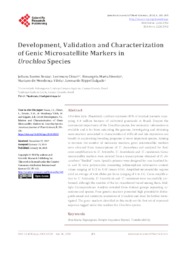Development, Validation and Characterization of Genic Microsatellite Markers in Urochloa Species.
Development, Validation and Characterization of Genic Microsatellite Markers in Urochloa Species.
Autoria: SOUZA, J. S.; CHIARI, L.; RESENDE, R. M. S.; VILELA, M. de M.; SALGADO, L. R.
Resumo: Urochloa (syn. Brachiaria ) cultivars represent 85% of tropical pastures occupying 114 million hectares of cultivated grasslands in Brazil. Despite the commercial importance of the Urochloa species, low molecular information is available and is far from saturating the genome. Investigating and obtaining more markers associated to characteristics of difficult and late expression can benefit in accelerating breeding programs of more important species. Aiming to increase the number of molecular markers, genic microsatellite markers were obtained from transcriptome of U. decumbens and analyzed for their cross-amplification to U. brizantha , U. humidicola and U. ruziziensis . Genic microsatellite markers were isolated from a transcriptome obtained of U. decumbens ?Basilisk? roots. Specific primers were designed for one hundred loci, and 32 were polymorphic presenting polymorphism informative content values ranging of 0.12 to 0.81 (mean 0.54). Amplified microsatellite regions yield an average of 4.44 alleles per locus (ranging of 1 to 13). Cross-amplification to U. brizantha , U. humidicola and U. ruziziensis were successfully performed, although the number of the loci transferred varied among them. Multiple orrespondence Analysis revealed three distinct groups separating accessions and species. Four genetic markers presented high potential to distinguish sexual and apomictic accessions of Urochloa and must be further investigated. The genic markers identified in this study are the first set of expressed sequence tagged molecular markers for Urochloa species.
Ano de publicação: 2018
Tipo de publicação: Artigo de periódico
Unidade: Embrapa Gado de Corte
Palavras-chave: Brachiaria, Signalgrass, Simple Sequence Repeat, Transferability
Observações
1 - Por padrão são exibidas publicações dos últimos 20 anos. Para encontrar publicações mais antigas, configure o filtro ano de publicação, colocando o ano a partir do qual você deseja encontrar publicações. O filtro está na coluna da esquerda na busca acima.
2 - Para ler algumas publicações da Embrapa (apenas as que estão em formato ePub), é necessário ter, no celular ou computador, um desses softwares gratuitos. Sistemas Android: Google Play Livros; IOS: iBooks; Windows e Linux: software Calibre.
Acesse outras publicações
Acesse a Base de Dados da Pesquisa Agropecuária (BDPA) para consultar o acervo completo das bibliotecas da Embrapa.

